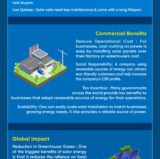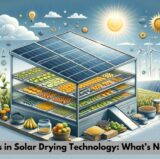As we move from conventional energy sources, solar energy seems to be one of the affordable and mass choice. Installing solar panels at home, or even for commercial purposes provides us with a energy backup and reduces our energy costs giving maximum returns on investment.
Table of Contents
ToggleWhen it comes to solar panels most people often confused between bifacial vs monocrystalline solar panels. While both of they are equipped to capture energy from sunlight they have very different methods to work. Plus they also differ in their costs, benefits, and energy efficiency.
Bifacial vs Monocrystaline
Well, you would not be able to make the right decision without knowing about bifacial solar panels vs monocrystalline pros and cons.
| Feature | Monocrystaslline | Bifacial |
|---|---|---|
| Efficiency | Good | Better, depends on environment |
| Cost | Less | Higher |
| Durability | About 10 to 15 years | About 20 to 30 years |
| Space Saving | High | Less |
| Installation Ease | Easy, can be done DIY | Needs professional exertise |
| Suitability to Weather Conditions | Not adaptable except sunny environment | Can adapt with less sunlight and cloudy weather |
| Reflective Surroundings | Not needed | Increases efficiency |
| Feature | Monocrystalline | Bifacial |
| Aescetics | Slender Black design | Similar to monocrystalline |
| Long term Energy Savings | Sufficient | More conomies of scale |
Let us first exaplain each type of solar panel and then do a comparative analysis to help you make an informed choice.
Monocrystalline Solar Panels- What Are They?
As the name suggests, there is only a single layer of silicon in this type of solar panel. Their pyramid cell pattern observable under a microscope gives it a larger surface area to capture sunlight making it energy efficient.
These are the more traditional form of solar panels equipped to capture sunlight from one face which is connected with solar batteries to store the energy. Some of you may not be able to figure out the difference when it comes to monofacial vs monocrystalline ones.
See, monofacial means that they can capture sunlight from the front end only. And monocrystalline has more to do with the strcturre where the solar panels are made up of only a single layer of silicon.
As you can think of, these are the more readily available solar panels you will come across in the market.
How Does it Work?
Monocrystalline solar panel has a front end or the photovoltaic side from which it captures the energy. They can carry the sunlight to a connected cell and store the energy. These panels have an upper layer coating which is usually to protect the solar panel from any type of climate adversity like rain, dust, snow, and others. This layer helps it make it more durable and long-lasting.
Benefits
Let us find out about the benefits of this type of solar panel-
Low-Cost Solution
Due to its simple design, it is the more affordable and durable solution if you are to install it on rooftops.
Reliable
Well, these types of panels were the ones that were first invented so they have been used for many years with most users happy and satisfied with their long-life service. Q
Huge Area for Applications
Being easy to install, they are good to go for both homely and industrial purpose use.
Low maintenance
The monocrystalline solar panels do not have much maintenance cost. Due to its simple design and built-in protective layer, all you need to do is clean them using a piece of cloth from time to time.
Factors to Keep in Mind When Installing
A few things have to be kept in mind at the time of installing them. Here is a checklist for the buyers-
- Consider their location as they can only absorb sunlight from one end. Choose an open area with little shade and obstruction of trees so that they can capture sunlight throughout most parts of the day.
- Choosing the size is also critical since the larger it gets the more energy it can generate. You need to have an idea of your energy needs.
Introducing Bifacial Solar Panels
Bifacial monocrystalline solar panelis similar to the monofacial panels. The only difference here is that these solar panels have a reflective coating at the back of it. There are dual panes inside these panels that make it capable of capturing the reflected light as well. So, as you can guess, these solar panels are much more energy efficient since they can capture the reflected light as well so that little sunlight goes to waste.
How Do They Work?
So, both ends that is the front and the back end of these bifacial panels can absorb sunlight. Let us understand how it happens-
- From the Front Side
This is similar to any traditional solar panel where it can absorb sunlight and start generating energy. The front side is coated with an anti-glare coating so that it can absorb maximum sunlight.
- From the Back
The back side of bifacial solar panelsis made with transparent glass which usually reflects off other surfaces. The back side is eventually able to capture this reflected light as well for energy output.
Benefits
The ability to capture sunlight from both ends does come with some great benefits. Let us find out about them-
More efficient
With the back side of the panel can capture reflective light there is no doubt that these solar panels are much more energy efficient than the traditional ones.
Better Yield in Energy
Being able to capture light from both ends means that it can give more energy yield per unit area of installation.
Ability to Perform in Different Conditions
These solar panels are much better at capturing energy where sunlight varies through the day or the climate remains cloudy.
Different Areas to Use
They be installed on homes, buildings, or even on walls making them able to capture more energy.
Factors to Consider When Installing Them
With more energy efficiency, in them, you will want to buy them from a top-rated manufacturer in town. Most of the companies are also giving warranties on them that are for 20 to 30 years depending on the product quality and type.
Do They Need Special Mounting Structures?
This type of solar panel needs a unique and specially designed mounting structure to avoid shade formation at the back. The beams that hold the structure must be aware of the area covering the solar panel. Plus they cannot be installed on a single-axis tracking system or else the rotation of the axis will cover the back side of the solar panel.
Main Differences Bifacial vs. Monocrystalline Solar Panels
So, let us find out about the main differences between the two-
Design
The design of the monocrystalline solar panels is traditional and more complex than the bifacial solar panels. The latter has a reflective coating at the back that can re-capture reflected sunlight.
Energy Efficiency
If you talk about bifacial vs. monofacial efficiency, the bifacial is the clear winner here. Their ability to capture sunlight from both faces makes sure that very little sunlight goes to waste. With high quality, they can capture almost 95% of sunlight.
Energy output
If you have a clear idea of how both work there should be no doubt in wondering why bifacial solar panels are capable of providing more energy output. They can capture sunlight from both faces and more capture sunrays means more energy.
Cost
When it comes to monofacial bifacial solar panel price, the former is cheaper on upfront cost. Generally, bifacial solar panels have a higher investment cost. However, over a longer tenure, it can provide a better return on investment than monofacial solar panels.
Other Things to Consider At The Time of Installation
There are a few other things to consider as well if you are looking to install one of the two models. Here is a checklist about bifacial solar panels vs. monocrystalline which one is better–
Durability
On the durability side, bifacial solar panels should be your choice since they come with a glass back. This is more durable than the monofacial which is vulnerable from the back. Some bifacial solar panels may give durability lasting several decades.
Suitability For Different Environments
The monocrystalline ones are better for installation in homes. However, the bifacial ones can adapt toretail and industrial needs with large-scale installation in factories that run on solar power mostly. If you consider monofacial bifacial solar panel efficiency, the latter is a much better option.
Shade and Reflection
Shade is one of the major problems with monofacial solar panels. But since the bifacial ones can capture reflected light from the back they may work better in shady areas with a reflective surface.
Space
Monofacial solar panels need much less space than bifacial solar panels because of their generic shape and design.
FAQs
If you are installing it for your homes, as a backup power source, it is better to go with the monocrystalline solar panels because of their cheap cost, reliability, and durability.
The bifacial solar panels would be a better option for those industries that run mostly on solar energy for certain operations or those that need power sources around the clock.
Yes, with their ability to capture reflected light, bifacial solar panels, although costly up front may provide a better return on your investment over a few decades. However, there is an initial investment where the cost difference between monofacial and bifacial solar panels can be huge with the latter being way too costly.




